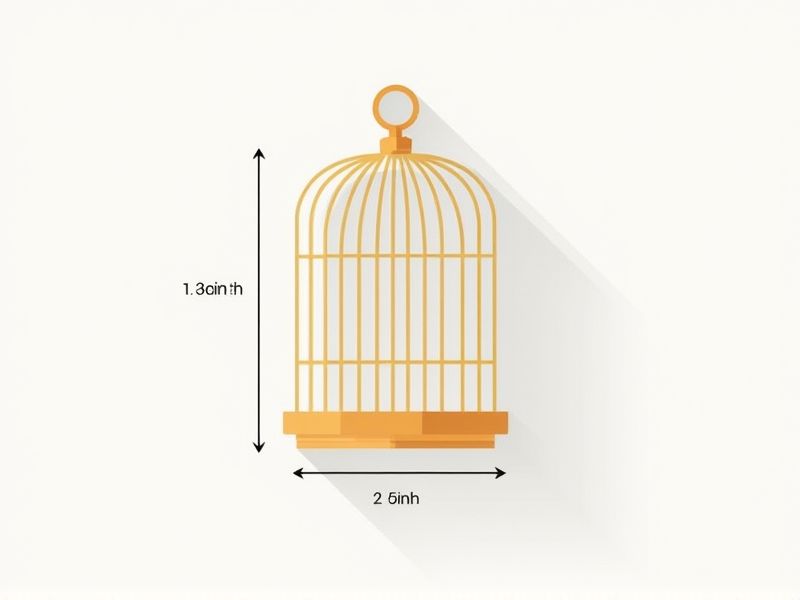
When selecting a birdcage, it's important to consider both the size and species of your bird. As a general rule, a cage for small birds like parakeets or finches should be at least 18x18x18 inches, while medium-sized birds like cockatiels or conures require cages around 24x24x24 inches. For larger birds such as African greys or amazons, look for cages with minimum dimensions of 36x24x48 inches to ensure adequate space for movement and wing stretching. Always remember that providing a larger cage than the minimum recommended will greatly benefit your bird's health and well-being.
Diameter
The diameter of a birdcage is a crucial factor in ensuring the well-being of your pet, as it directly affects the space available for movement and comfort. A standard birdcage for small birds, such as parakeets or canaries, typically ranges from 18 to 24 inches in diameter. For medium-sized birds like cockatiels, a diameter of 24 to 30 inches is recommended, while larger birds such as African greys or macaws may require a diameter of 36 inches or more. Ensuring ample diameter not only promotes physical activity but also reduces stress, leading to a healthier and happier bird.
Height
The standard height for a birdcage typically ranges from 24 to 36 inches, providing ample vertical space for various species. A taller cage not only allows birds to exhibit natural behaviors such as flying and climbing but also enhances their overall well-being. When selecting a birdcage, ensure that the height accommodates the wingspan of your feathered friend; for example, budgerigars benefit from a cage height of at least 30 inches. Prioritizing height in your birdcage design is crucial for promoting a healthy, active life for your pet.
Bar Spacing
The standard bar spacing for birdcages varies by species, typically ranging between 0.5 to 1 inch for small birds like finches and canaries, while larger birds such as parrots may require 1 to 2 inches. Proper bar spacing ensures the safety and security of your birds, preventing escape or injury. For optimal comfort, choose a cage design that allows adequate room for movement; a minimum interior space of 24 x 18 x 18 inches is recommended for smaller species. Always prioritize the species-specific needs for bar spacing to promote a healthy, stress-free environment for your feathered friends.
Bar Thickness
The standard for birdcage design emphasizes the importance of bar thickness, typically ranging from 3mm to 5mm for optimal durability and safety. Thicker bars provide enhanced structural integrity, preventing deformation and escape attempts. Recommended spacing between bars is usually around 1 inch, ensuring the safety of small birds while allowing visibility. Choosing the right bar thickness not only enhances your birdcage's longevity but also contributes to the comfort of your feathered companions.
Base Shape
A standard birdcage typically features a round or rectangular base shape, which ensures stability and ample space for the birds. The dimensions of the base often range from 24 to 36 inches in length, accommodating a variety of species. This design not only supports the structure of the cage but also allows for easy access and maintenance, facilitating your bird care routine. When selecting a birdcage, consider the base shape as a crucial factor for your feathered friends' comfort and well-being.
Material
The birdcage material significantly influences its durability, aesthetics, and overall safety. Premium options include wrought iron, which offers exceptional strength and a classic appearance, while stainless steel provides corrosion resistance and easy maintenance. Research indicates that birdcages made from non-toxic materials, such as safe powder coatings, are essential for the health of your pet birds. When selecting a cage, consider factors like bar spacing of 1/2 to 1 inch, ensuring proper ventilation and preventing escape.
Door Size
When selecting a birdcage, door size is a critical factor for ensuring accessibility and ease of use. A standard door opening should range from 10 to 12 inches in width and height, accommodating various bird species, particularly larger breeds such as parrots or cockatoos. This size allows for effortless access for tasks such as feeding and cleaning, while also facilitating the natural movement of your pet. Ensuring that the door is secure and easy to operate is essential for the safety and comfort of your feathered companion.
Interior Volume
The interior volume of a birdcage is crucial for ensuring your pet's comfort and well-being. Ideally, a cage should provide at least 4 square feet of floor space per bird, with a minimum height of 24 inches for smaller species. This volume allows for ample room to move around, stretch wings, and engage in natural behaviors. When selecting a birdcage, prioritize spacious designs that accommodate perch placement and space for toys, thereby enhancing the overall habitat for your feathered friend.
Perch Positioning
The ideal perch positioning in a birdcage is crucial for the comfort and well-being of your avian companion. Perches should be placed at varying heights to promote natural movement, allowing birds to exercise their wings and legs effectively. A general guideline is to have at least one perch within 18-24 inches of the cage floor to accommodate resting behavior. Using perches made from natural wood with varying diameters (between 3/4 inch to 1 1/4 inches) will also help maintain foot health and encourage natural behaviors.
Accessories Placement
The ideal birdcage design emphasizes the strategic placement of accessories to enhance the well-being of your feathered friends. Position perches at varying heights, ensuring at least three per cage to encourage natural movement and exercise, while keeping them 1-2 inches apart. Incorporate toys, like ropes and bells, which should take up at least 20% of the cage space without causing overcrowding. For feeding areas, use two stainless steel bowls to easily accommodate a balanced diet, and place them at opposite ends to promote exploration.
